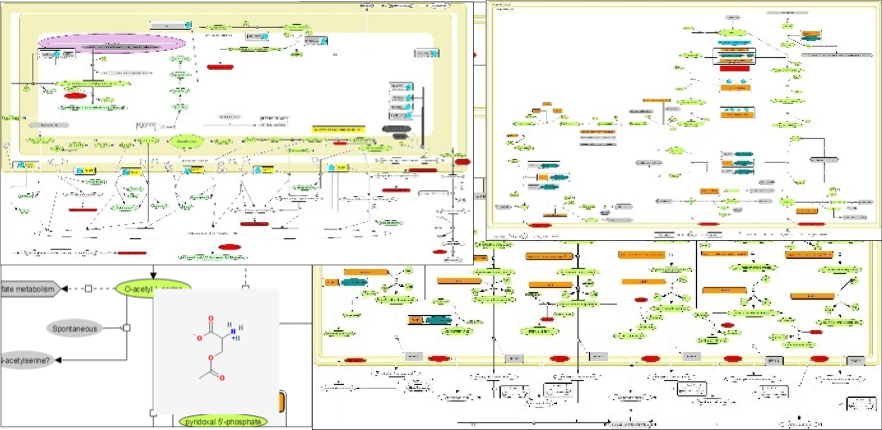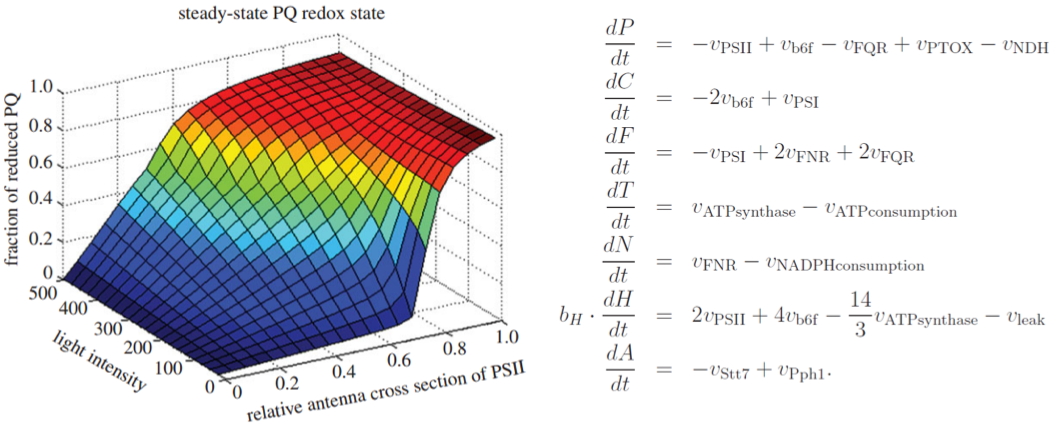Research Topic
3. Role of organelle interaction in optimizing carbon assimilation
Gilles Curien and Giovanni Finazzi
In the course of evolution photosynthetic organisms developed sophisticated molecular regulatory mechanisms allowing optimization of light capture and distribution of the energy temporally stored in carbon/redox compounds. The molecular details and the integrated functioning of these dynamical systems is still not well understood. Improvement on our understanding requires to fill in the bridge between abundant (but still insufficient) molecular details, communication between mitochondria (the motor) and chloroplast (the solar panel) and systems behavior at the cellular level. Our recent data (Bailleul et al., 2015) indicate that this mechanism is particularly relevant in diatoms, i.e. organisms that have been dominating photosynthetic marine eukaryotes in the last 35 millions of years. In diatoms, regulation of the ATP/NADPH ratio for proper carbon assimilation occurs through extensive energetic exchanges between plastids and mitochondria (Figure 4). This interaction comprises the rerouting of reducing power generated in the plastid towards mitochondria and the import of mitochondrial ATP into the plastid, and is mandatory for optimized carbon fixation and growth. We propose that the process may have contributed to the ecological success of diatoms in the ocean (see our highlights).
Figure 4:
Representation of a diatom and of the cellular mechanisms coupling photosynthesis and respiration in that organism.
The chloroplast, producing ATP and NADPH thanks to light, is closely associated to the mitochondria where respiration occurs.
These two sub-cellular compartments can thus exchange the ATP or the NADPH molecule that they produce optimizing CO2 fixation in diatoms.
QUESTIONS
In this project we want to investigate the mechanisms regulating the energy fluxes. Unlike a power station, which supplies only one form of energy, electricity, the chloroplast must supply both ATP and NADPH in precisely the right proportion to match consumption. The ATP/NADPH ratio and its control set into place by photosynthetic organisms during evolution under natural evolutionary pressure is expected not to be optimal for biotechnological applications. In order to manipulate the ATP/NADPH ratio we have started identifying the molecular actors responsible for the synthesis (e.g. NAD+ kinase and its control), and exchange (i.e. the malate shuttle in diatoms) of reducing power in plants and algae. Our goal is to build a comprehensive model of energy fluxes in the plant cell starting from a detailed description of metabolism in algae. For this we will extend our expertise in modelling metabolism from the model plant Arabidopsis thaliana (Curien et al., 2009, Curien et al., 2014) to other organisms using metabolic reconstructions (Figure 5) and modelling in collaboration with EDyP team (our institute, BGE laboratory, CEA-Grenoble) and partners from abroad (O. Ebenhöh, Ebenhöh et al., 2014,Figure 6), in the frame of a Marie Curie ITN project (AccliPhot project), which includes 12 partners from six different European countries.
Figure 5:
Reconstruction of metabolic networks. The understanding of multi-compartimented processes involving thousands of compounds (proteins, metabolites, membranes)
and multi-level controls (phosphorylation, allosteric controls, transport processes) requires the development of new visualisation tools. Such bioinformatics
tools are useful to generate new hypotheses and interpret data but also to communicate and transmit knowledge across generations. The experience acquired
on the reconstruction of A. thaliana metabolism (work in progress in collaboration with team 1, team 3 and EDyP team (our institute, BGE laboratory,
CEA-Grenoble - GRAL project) will be re-invested for in silico reconstruction of algae metabolism dedicated to a detailed representation of energetic processes.
Figure 6:
Short-term acclimation of the photosynthetic electron transfer chain to changing light: A mathematical model Ebenhöh et al., 2014.
We are also developing biotechnology application of our studies to improve algal biomass productivity, in collaboration with the French SME Fermentalg.




